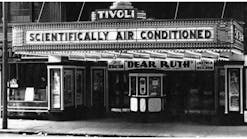Undergoing a 72,000-sq-ft expansion, Davis Memorial Hospital in Elkins, W.V., was looking to overcome recurring cooling-tower-related HVAC-performance problems. Sought was a more advanced cooling-tower technology that would optimize performance and minimize maintenance requirements.
“I researched various cooling-tower technologies on the Internet and found a unique line of cooling towers featur(ing) a seamless plastic shell,” Director of Support Services Steven Johnson said. “The one that attracted my attention was a line that was made of high-density polyethylene (HDPE) manufactured by Delta Cooling Towers.”
Unlike metal cooling-tower shells, which are vulnerable to corrosion from salt air, industrial gases, and even the chemicals used to treat recirculating water, HDPE cooling-tower shells are virtually impermeable to corrosive elements, including water-treatment chemicals, as well as ultraviolet rays.
Johnson and engineers from Davis Memorial toured Delta Cooling Towers’ manufacturing facility in West Virginia to get a closer look at the design and construction of the cooling towers, which range in capacity from 10 to 2,000 cooling tons.
“We were all impressed with the plant tour,” Johnson said. “Not only was management helpful in explaining the features and benefits of various product models, but they also helped us confirm our preliminary specs for the cooling towers we had in mind. We were quite surprised to learn that this line of cooling towers (was) about 20 percent less expensive than many conventional designs.”
Johnson also was pleased with the warranty. While many metal-clad cooling towers are warranted for a year, HDPE-based cooling-tower shells from Delta are warranted for 20 years.
Davis Memorial selected two cooling towers—a 250-ton TM Series induced-draft unit and a 180-ton Paragon induced-draft unit—to support its two 300-ton Carrier chillers.
Johnson said the variable-speed, direct-drive motors running the towers’ fans provide unexpected benefits.
“First of all, these drives are far more efficient than we initially realized,” Johnson said. “The fan motors on our old towers were 30 hp each and consumed considerably more energy than the new ones, which are only 7 hp each and at least 50 percent more energy-efficient.”
Johnson said the hospital’s old fan motors were either on or off. The new variable-speeds drives are set up to run at 100 percent only on a hot day.
“The new direct-drive fans are usually running at about 40 percent,” Johnson said. “Running at 100 percent, they are only pulling 4 amps, which is much less energy than before.”
Johnson added that the new direct drives also are far less maintenance-intensive. With no belts, shafts, bearings, or other external parts to service, the direct-drive motors are virtually maintenance-free.
Another important benefit of the new direct-drive cooling towers is their quiet operation.
“Drives using belts often require adjustments, or you will hear them squeal,” Johnson said. “We’re a hospital, so quiet is expected. Also, we’re located right in the middle of a residential community. In the past, we received complaints from people in the neighborhood if the belts were squealing, particularly if it happened at night when they were trying to sleep. That was a serious problem, so our maintenance people often had to fix the belts in the middle of the night. With the direct-drive fan motors, we don’t have that problem.”
Johnson said the cooling towers have exceeded expectations.
“These new cooling towers have virtually eliminated unscheduled emergency maintenance,” Johnson said. “That not only makes us happy, our chiller-maintenance contractor is also very pleased.”
John Flaherty, president of Delta Cooling Towers, estimated that with the combined savings on energy, water, maintenance, and chemicals the hospital is realizing, payback for the new cooling towers should be less than two years.
For Design Solutions author guidelines, call Scott Arnold, executive editor, at 216-931-9980, or write to him at [email protected].









